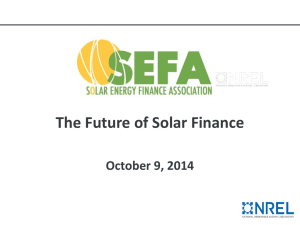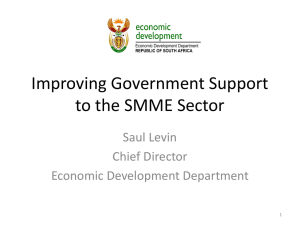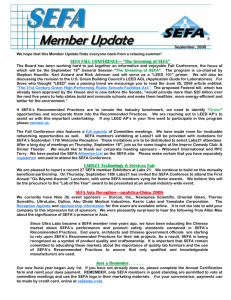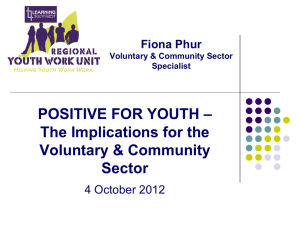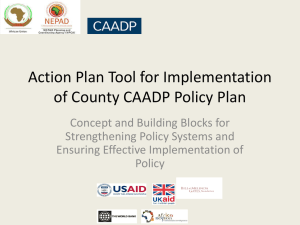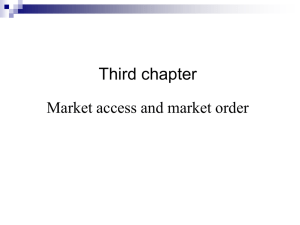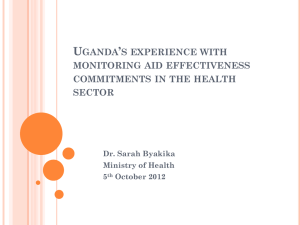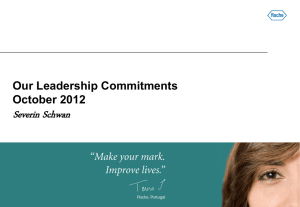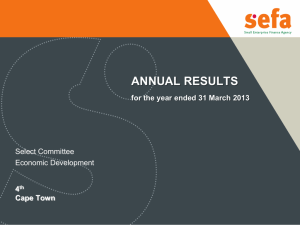Commitments (1 of 2)
advertisement
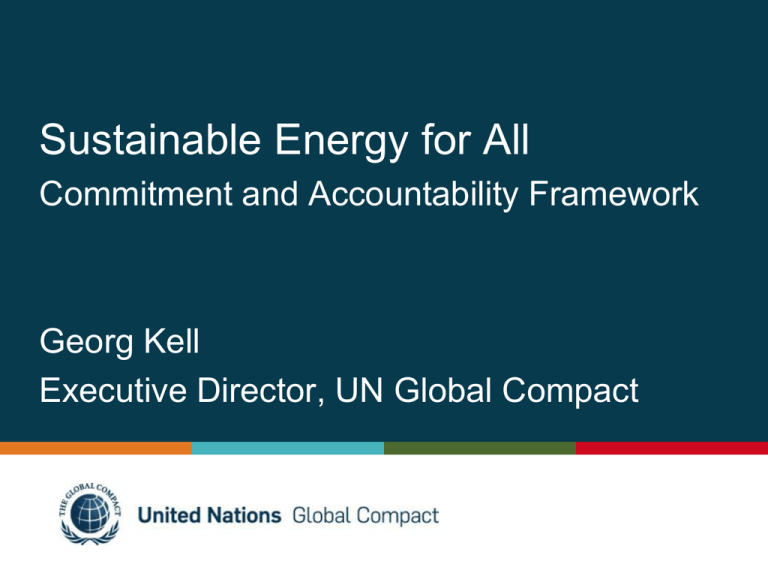
Sustainable Energy for All Commitment and Accountability Framework Georg Kell Executive Director, UN Global Compact Key questions for consideration 1. What is the role for commitments under SEFA? 2. What constitutes a commitment to SEFA? 3. Do we need a screening process? What could it look like? 4. How do we hold organizations (and governments) accountable for the commitments they make? 2 Building on Ten Years Experience with Corporate Commitments • 6000+ companies in 100+ Local Networks • Voluntary commitment to integrating the ten GC principles into strategies and operations and taking action in support of UN goals • Key attributes of core UNGC framework include – CEO commitment and Board endorsement – Continuous progress model – Accountability framework (annual COP requirement) – Strict logo policy and brand management • SEFA framework to drive new effort to systemize corporate commitments to wider set of UN goals on a system-wide platform (business.un.org) 3 What is the role of commitments under SEFA? • Objectives – Mobilize action and partnerships realizing three objectives – Demonstrate widespread multi-sector support for the SEFA initiative • Key considerations – – – – – Voluntary -- Regulatory Public -- Private (3GF) Awareness -- Commitment -- Action Quantity -- Quality -- Focus Accountability 4 What constitutes a commitment to SEFA? (1/3) • A commitment is a promise to take action in the future, alone or in partnership with others, including: • • • • New projects or partnerships; Scaling up or accelerating existing activities Adding additional partners to existing projects Also include renewal of commitments made in the recent past, if activities to realize commitment are still ongoing • How do we avoid punishing early-movers? • • • Ambitious efforts that have been successfully completed should be recognized and promoted as inspiration for others; Special recognition for commitment-makers that are clearly ahead of others in its sector Other??? 5 What constitutes a commitment to SEFA? (2/3) • Fall within the high-impact areas of the Action Agenda • Align with sector-specific best practices (20 industries) Chemical industry example Access to Energy CORE BUSINESS: OPERATIONS ADVOCACY & PUBLIC POLICY ENGAGEMENT Renewable Energy Develop products and services that drive customer / consumer energy efficiency or enable increased renewable energy uptake Develop more renewable feedstocks and bio-based building Use more energy efficient techniques blocks for commodity and to generate electricity and steam intermediary chemicals and run operational processes Use more renewable energy sources to satisfy operational Establish an integrated, enterprise energy needs and prioritize energy management function in investments in this area your organization Improve the energy efficiency of your products and services CORE BUSINESS: PRODUCTS & SERVICES SOCIAL INVESTMENT & PHILANTHROPY Energy Efficiency Beneficially reuse waste streams to provide access to energy Support legislation and regulation related to the establishment of a price signal for carbon and renewable fuel standards Each sample best practice comes with a detailed description and illustrative case studies 6 What constitutes a commitment to SEFA? (3/3) • Complete set of suggested criteria: Promise to take action in the future • • • • Aligned with high-impact areas and sector specific best practices Leadership commitment (CEO signature required for companies?) Identify time-bound targets and KPI’s Include description of resources dedicated to realize commitment Commitment to transparency through annual reporting on progress • A simple template reflecting this criteria will be developed to ease both submission and review of commitments 7 Do we need a screening process? • Screening, formal or not, is required to – Verify that commitment meet criteria and align with action agenda – Single out high-impact commitments that should be positively differentiated (media outreach, speaking opportunities, etc) • Higher impact commitments • Safeguard integrity of the UN and SEFA 8 What could a screening process look like? • Should be very efficient in terms of both time and cost: Need to process, hopefully, high quantity of commitments within a few months) • Technical review by experts working on soliciting commitments from the various sectors • Coupled with oversight by a legitimate body, e.g. a small group of high-level UN officials 9 How do we hold organizations (and governments) accountable for the commitments they make? • Transparency around the commitments made, also in the months and years after the commitment is announced, in itself allows for public scrutiny and thus increases accountability; • In addition, the main accountability measure suggested is an annual communication on progress requirement: – Brief description of progress made in realizing commitment and brief description of future plan of action – Included into existing communication to stakeholders – Optional 3rd party review of communication on progress – UN to list non-communicating organizations and governments • Beyond accountability, communication on progress will allow for aggregated monitoring of progress and facilitate learning 10 Next Steps • Develop “Call for Commitments” materials, including (translation!) – Section on Sustainable Energy for All web site – Brief, sector-specific publications • Align sector-specific best practices (developed with SEFA, LEAD and C4C companies) with high impact areas of Action Agenda; • Collect and promote illustrative case examples; • Work with SEFA as well as LEAD and C4C companies to get first round of high-impact commitments • Outreach through regional SEFA launches and Global Compact Local Networks 11 Key questions for consideration 1. What is the role for commitments under SEFA? 2. What constitutes a commitment to SEFA? 3. Do we need a screening process? What could it look like? 4. How do we hold organizations (and governments) accountable for the commitments they make? 12 Sustainable Energy for All Draft Commitment and Accountability Framework How do we make it attractive to make commitments? • Companies/governments can and should only be expected to make commitments that make good business/policy sense • But SEFA can cause companies/governments to start earlier, go further and increase collaboration by: – Advocating the need for action and promoting best practices and leadership examples; – Letting the light shine on commitment-makers (events, awards, web site, press releases, etc) – Allowing companies (and others) to associate themselves with SEFA, and by extension the UN, in their own communications. – This could include a special version of the SEFA logo that commitmentmakers could use to increase the branding recognition value of making a commitment (with logo/brand policy) 14


